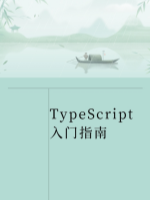07 | 接口(1):对象类型接口
在TypeScript的世界中,接口(Interfaces)是一种强大的工具,用于定义对象的形状,即对象中包含哪些属性以及这些属性的类型。接口不仅有助于代码的规范化和维护,还能在编译时期捕获类型错误,提高开发效率和软件质量。本章将深入探讨TypeScript中的对象类型接口,从基础概念到高级应用,逐步揭开其神秘面纱。
一、接口的基本概念
在TypeScript中,接口是一个抽象的类型定义,它描述了对象的结构,但不实现它。接口可以包含属性、方法签名(但不实现方法体)以及索引签名等。接口的主要作用是作为类型注解使用,强制变量、函数参数或返回值等符合其定义的结构。
interface Person {name: string;age: number;greet(): void; // 方法签名}let person: Person = {name: "Alice",age: 30,greet: function() {console.log(`Hello, my name is ${this.name}`);}};
在上述示例中,Person接口定义了三个成员:两个属性name和age,以及一个方法greet。然后,我们创建了一个person对象,它实现了Person接口所要求的结构。
二、属性接口
属性接口是最基础的接口形式,仅包含属性的定义。在TypeScript中,任何具有相同属性的对象都可以被视为实现了该接口,无论它们是如何被创建的。
interface SquareConfig {color?: string; // 可选属性width: number;}function createSquare(config: SquareConfig): { color: string; area: number } {let newSquare = { color: "white", area: config.width * config.width };if (config.color) {newSquare.color = config.color;}return newSquare;}let mySquare = createSquare({ width: 10 });
在SquareConfig接口中,color属性是可选的(通过?标记),而width属性是必须的。createSquare函数接受一个SquareConfig类型的参数,并返回一个对象,该对象包含color和area属性。这里展示了如何在函数参数中使用接口,以及如何处理可选属性。
三、只读属性
在接口中,我们可以将属性标记为只读,这意味着一旦属性被赋值后,其值就不能被修改。这通过使用readonly关键字实现。
interface Point {readonly x: number;readonly y: number;}let p1: Point = { x: 10, y: 20 };// p1.x = 5; // 这将引发编译错误
在Point接口中,x和y属性都被标记为只读。尝试修改这些属性的值将会导致编译错误。
四、接口中的函数类型
虽然接口主要用于描述对象的形状,但接口中的方法通常只包含签名,不包含实现。然而,这并不意味着接口不能用于描述函数类型。事实上,接口可以用来描述具有特定参数和返回类型的函数。
interface SearchFunc {(source: string, subString: string): boolean;}let mySearch: SearchFunc;mySearch = function(source: string, subString: string) {return source.search(subString) !== -1;};
在上面的例子中,SearchFunc接口定义了一个函数类型,该函数接受两个字符串参数source和subString,并返回一个布尔值。然后,我们声明了一个mySearch变量,其类型为SearchFunc,并赋予了一个具体的函数实现。
五、接口继承
接口之间也可以相互继承,这允许我们基于一个接口来定义另一个接口,从而复用属性和方法签名。
interface Shape {color: string;}interface Square extends Shape {sideLength: number;}let square = {} as Square;square.color = "blue";square.sideLength = 10;
在上面的例子中,Square接口通过extends关键字继承了Shape接口,从而获得了color属性,并添加了sideLength属性。
六、混合类型接口
TypeScript还允许创建混合类型的接口,即一个接口中既可以包含属性,也可以包含方法。此外,接口还可以描述一个对象可能同时作为函数和对象的类型。
interface Counter {(start: number): string;interval: number;reset(): void;}function getCounter(): Counter {let count = 0;let interval: number;const counter = function(start: number) {count = start;return `Counter initialized with ${start}`;};counter.interval = 123;counter.reset = function() {count = 0;};return counter;}let c = getCounter();console.log(c(10)); // "Counter initialized with 10"console.log(c.interval); // 123c.reset();console.log(c(5)); // "Counter initialized with 5"
在上面的例子中,Counter接口描述了一个既可作为函数又可包含属性和方法的对象。这种混合类型的接口在JavaScript中尤为常见,特别是在使用模块或类库时。
七、总结
对象类型接口是TypeScript中用于定义对象结构的重要工具。通过接口,我们可以确保代码的一致性和可维护性,同时利用TypeScript的类型检查能力来避免运行时错误。在本章中,我们学习了接口的基本概念、属性接口、只读属性、接口中的函数类型、接口继承以及混合类型接口等知识点。希望这些内容能帮助你更好地理解和使用TypeScript中的接口。在未来的章节中,我们将继续探索接口的高级应用,包括泛型接口、索引签名等,以进一步提升你的TypeScript编程技能。



